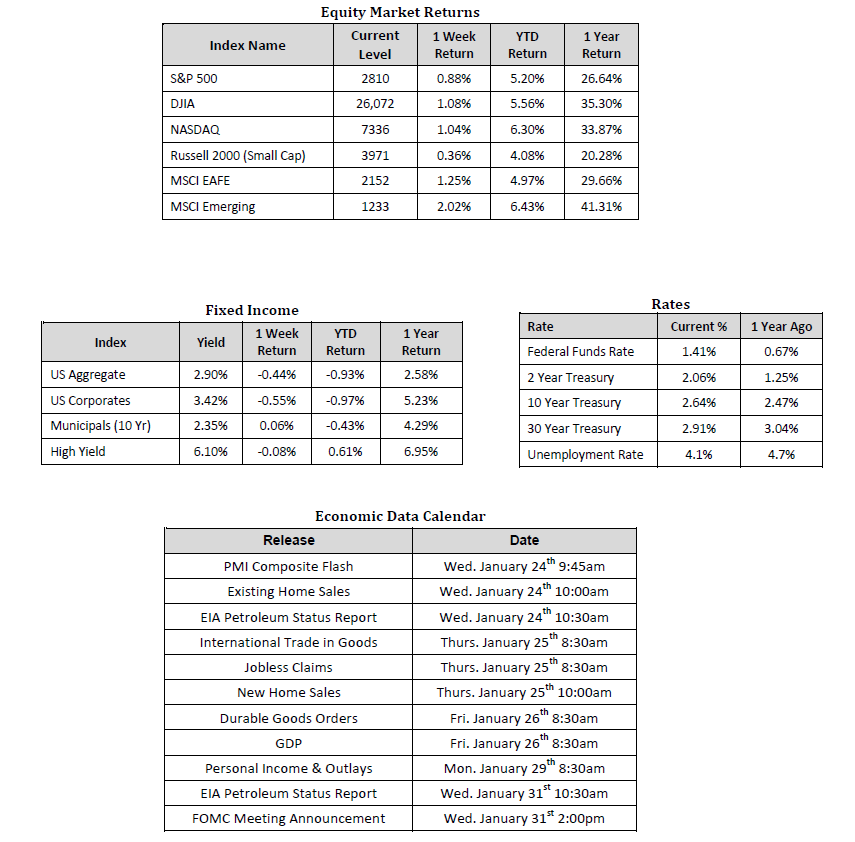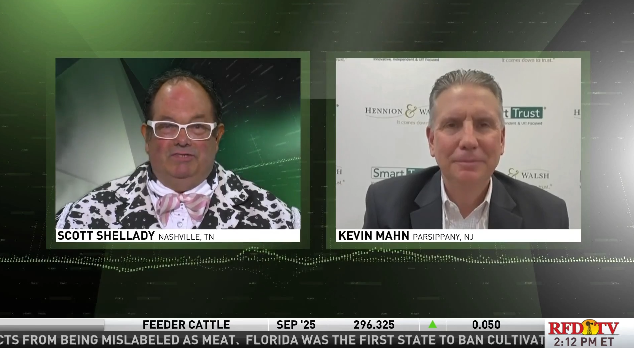
Another Advance in Stocks as Earnings Reports Start to Roll In
Market Overview
Sources: Sources for data in tables: Equity Market and Fixed Income returns are from JP Morgan as of 01/19/18. Rates and Economic Calendar Data from Bloomberg as of 01/22/18. International developed markets measured by the MSCI EAFE Index, emerging markets measured by the MSCI EM Index. Sector performance is measured using GICS methodology.
Happening Now
Stocks broadly gained again last week as economic data continues to surprise to the upside and traders prepare for the release of more corporate earnings reports from the 4th quarter of 2017. In the U.S., the S&P 500 Index gained 0.9%, the Russell Midcap Index advanced 0.5%, and the Russell 2000 Index, a gauge of U.S. small cap stocks, gained 0.4%. In terms of sector performance, Consumer Staples rebounded from last week’s loss with a 2.5% move higher while Energy gave back some of last week’s gains falling 1.3%. On the international front, developed markets advanced 1.3% while emerging markets posted a 2% gain.
The S&P 500 has advanced over 5% since the start of the year while international markets have generated similarly strong returns. Following the double digit gains enjoyed by global equity markets in 2017 that beat nearly all estimates, many Wall Street strategists are forecasting positive, but lower relative returns in 2018. The passage of U.S. tax reform, continued global economic growth, and the resulting prospect of universally strong earnings growth has propelled markets to again outperform most forecasts thus far this year. This upcoming week, several fourth quarter earnings announcements will likely dominate headlines. In the U.S., analysts are calling for an 11% gain in earnings which will help to keep prices in check with underlying fundamentals.
Some have expressed concern that the nearly 9-year old bull market has produced prices that are “too high” or valuations that are “stretched.” We respond to these concerns by impressing upon investors that there are structural forces in place to support current prices and even propel stocks higher. First, the current environment of low interest rates and benign macro-economic volatility help to put today’s prices in a more palatable context. Additionally, research suggests that high valuations are a poor barometer for near term returns with peaking Price-to-Earnings (P/E) ratio’s occurring months, if not years, before the start of bear market. Finally, double digit earnings growth should limit any widening in price multiples while potentially supporting further gains in stock prices.
While we believe that the argument for a stock market correction is weak, we also recognize that short-term pullbacks remain possible. As a result, we recommend that investors consult with a financial planner to develop an understanding of their goals and risk tolerance, as well as a portfolio manager who can design an asset allocation strategy that should help both capture the growth potential, and help limit the downside risk potential of the capital markets.
Important Information and Disclaimers
Disclosures: Hennion & Walsh is the sponsor of SmartTrust® Unit Investment Trusts (UITs). For more information on SmartTrust® UITs, please visit www.smarttrustuit.com. The overview above is for informational purposes and is not an offer to sell or a solicitation of an offer to buy any SmartTrust® UITs. Investors should consider the Trust’s investment objective, risks, charges and expenses carefully before investing. The prospectus contains this and other information relevant to an investment in the Trust and investors should read the prospectus carefully before they invest.
Investing in foreign securities presents certain risks not associated with domestic investments, such as currency fluctuation, political and economic instability, and different accounting standards. This may result in greater share price volatility. These risks are heightened in emerging markets.
There are special risks associated with an investment in real estate, including credit risk, interest rate fluctuations and the impact of varied economic conditions. Distributions from REIT investments are taxed at the owner’s tax bracket.
The prices of small company and mid cap stocks are generally more volatile than large company stocks. They often involve higher risks because smaller companies may lack the management expertise, financial resources, product diversification and competitive strengths to endure adverse economic conditions.
Investing in commodities is not suitable for all investors. Exposure to the commodities markets may subject an investment to greater share price volatility than an investment in traditional equity or debt securities. Investments in commodities may be affected by changes in overall market movements, commodity index volatility, changes in interest rates or factors affecting a particular industry or commodity.
Products that invest in commodities may employ more complex strategies which may expose investors to additional risks.
Investing in fixed income securities involves certain risks such as market risk if sold prior to maturity and credit risk especially if investing in high yield bonds, which have lower ratings and are subject to greater volatility. All fixed income investments may be worth less than original cost upon redemption or maturity. Bond Prices fluctuate inversely to changes in interest rates. Therefore, a general rise in interest rates can result in the decline of the value of your investment.
Definitions
MSCI- EAFE: The Morgan Stanley Capital International Europe, Australasia and Far East Index, a free float-adjusted market capitalization index that is designed to measure developed-market equity performance, excluding the United States and Canada.
MSCI-Emerging Markets: The Morgan Stanley Capital International Emerging Market Index, is a free float-adjusted market capitalization index that is designed to measure the performance of global emerging markets of about 25 emerging economies.
Russell 3000: The Russell 3000 measures the performance of the 3000 largest US companies based on total market capitalization and represents about 98% of the investible US Equity market.
ML BOFA US Corp Mstr [Merill Lynch US Corporate Master]: The Merrill Lynch Corporate Master Market Index is a statistical composite tracking the performance of the entire US corporate bond market over time.
ML Muni Master [Merill Lynch US Corporate Master]: The Merrill Lynch Municipal Bond Master Index is a broad measure of the municipal fixed income market.
Investors cannot directly purchase any index.
LIBOR, London Interbank Offered Rate, is the rate of interest at which banks offer to lend money to one another in the wholesale money markets in London.
The Dow Jones Industrial Average is an unweighted index of 30 “blue-chip” industrial U.S. stocks.
The S&P Midcap 400 Index is a capitalization-weighted index measuring the performance of the mid-range sector of the U.S. stock market, and represents approximately 7% of the total market value of U.S. equities. Companies in the Index fall between S&P 500 Index and the S&P SmallCap 600 Index in size: between $1-4 billion.
DJ Equity REIT Index represents all publicly traded real estate investment trusts in the Dow Jones U.S. stock universe classified as Equity REITs according to the S&P Dow Jones Indices REIT Industry Classification Hierarchy. These companies are REITSs that primarily own and operate income-producing real estate.




